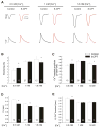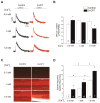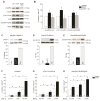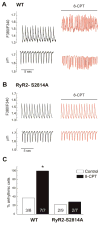Early effects of Epac depend on the fine-tuning of the sarcoplasmic reticulum Ca2+ handling in cardiomyocytes
- PMID: 29037982
- PMCID: PMC5801154
- DOI: 10.1016/j.yjmcc.2017.10.005
Early effects of Epac depend on the fine-tuning of the sarcoplasmic reticulum Ca2+ handling in cardiomyocytes
Abstract
In cardiac muscle, signaling through cAMP governs many fundamental cellular functions, including contractility, relaxation and automatism. cAMP cascade leads to the activation of the classic protein kinase A but also to the stimulation of the recently discovered exchange protein directly activated by cAMP (Epac). The role of Epac in the regulation of intracellular Ca2+ homeostasis and contractility in cardiac myocytes is still matter of debate. In this study we showed that the selective Epac activator, 8-(4-chloro-phenylthio)-2'-O-methyladenosine-3', 5'-cyclic monophosphate (8-CPT), produced a positive inotropic effect when adult rat cardiac myocytes were stabilized at low [Ca2+]o (0.5mM), no changes at 1mM [Ca2+]o and a negative inotropic effect when [Ca2+]o was increased to 1.8mM. These effects were associated to parallel variations in sarcoplasmic reticulum (SR) Ca2+ content. At all [Ca2+]o studied, 8-CPT induced an increase in Ca2+ spark frequency and enhanced CaMKII autophosphorylation and the CaMKII-dependent phosphorylation of SR proteins: phospholamban (PLN, at Thr17 site) and ryanodine receptor (RyR2, at Ser2814 site). We used transgenic mice lacking PLN CaMKII phosphorylation site (PLN-DM) and knock-in mice with an inactivated CaMKII site S2814 on RyR2 (RyR2-S2814A) to investigate the involvement of these processes in the effects of Epac stimulation. In PLN-DM mice, 8-CPT failed to induce the positive inotropic effect at low [Ca2+]o and RyR2-S2814A mice showed no propensity to arrhythmic events when compared to wild type mice myocytes. We conclude that stimulation of Epac proteins could have either beneficial or deleterious effects depending on the steady-state Ca2+ levels at which the myocyte is functioning, favoring the prevailing mechanism of SR Ca2+ handling (uptake vs. leak) in the different situations.
Keywords: CaMKII-dependent phosphorylations; Epac; Sarcoplasmic reticulum calcium handling.
Copyright © 2017 Elsevier Ltd. All rights reserved.
Conflict of interest statement
Figures





Similar articles
-
Phospholamban ablation rescues the enhanced propensity to arrhythmias of mice with CaMKII-constitutive phosphorylation of RyR2 at site S2814.J Physiol. 2016 Jun 1;594(11):3005-30. doi: 10.1113/JP271622. Epub 2016 Feb 2. J Physiol. 2016. PMID: 26695843 Free PMC article.
-
The cAMP binding protein Epac modulates Ca2+ sparks by a Ca2+/calmodulin kinase signalling pathway in rat cardiac myocytes.J Physiol. 2007 Sep 1;583(Pt 2):685-94. doi: 10.1113/jphysiol.2007.133066. Epub 2007 Jun 28. J Physiol. 2007. PMID: 17599964 Free PMC article.
-
CaMKII-dependent phosphorylation of cardiac ryanodine receptors regulates cell death in cardiac ischemia/reperfusion injury.J Mol Cell Cardiol. 2014 Sep;74:274-83. doi: 10.1016/j.yjmcc.2014.06.004. Epub 2014 Jun 17. J Mol Cell Cardiol. 2014. PMID: 24949568 Free PMC article.
-
Epac in cardiac calcium signaling.J Mol Cell Cardiol. 2013 May;58:162-71. doi: 10.1016/j.yjmcc.2012.11.021. Epub 2012 Dec 7. J Mol Cell Cardiol. 2013. PMID: 23220153 Review.
-
Cardiac ryanodine receptor phosphorylation by CaM Kinase II: keeping the balance right.Front Biosci (Landmark Ed). 2009 Jun 1;14(13):5134-56. doi: 10.2741/3591. Front Biosci (Landmark Ed). 2009. PMID: 19482609 Review.
Cited by
-
Compartmentalized cAMP signalling and control of cardiac rhythm.Philos Trans R Soc Lond B Biol Sci. 2023 Jun 19;378(1879):20220172. doi: 10.1098/rstb.2022.0172. Epub 2023 May 1. Philos Trans R Soc Lond B Biol Sci. 2023. PMID: 37122225 Free PMC article. Review.
-
Integration of Rap1 and Calcium Signaling.Int J Mol Sci. 2020 Feb 27;21(5):1616. doi: 10.3390/ijms21051616. Int J Mol Sci. 2020. PMID: 32120817 Free PMC article. Review.
-
Epac Function and cAMP Scaffolds in the Heart and Lung.J Cardiovasc Dev Dis. 2018 Feb 3;5(1):9. doi: 10.3390/jcdd5010009. J Cardiovasc Dev Dis. 2018. PMID: 29401660 Free PMC article. Review.
-
Effect of zearalenone on the jejunum of weaned gilts through the Epac1/Rap1/JNK pathway.J Anim Sci. 2024 Jan 3;102:skae208. doi: 10.1093/jas/skae208. J Anim Sci. 2024. PMID: 39051732 Free PMC article.
References
-
- Oestreich EA, Wang H, Malik S, Kaproth-Joslin KA, Blaxall BC, Kelley GG, Dirksen RT, Smrcka AV. Epac-mediated activation of phospholipase C(epsilon) plays a critical role in beta-adrenergic receptor-dependent enhancement of Ca2+ mobilization in cardiac myocytes. J Biol Chem. 2007;282:5488–5495. doi: 10.1074/jbc.M608495200. - DOI - PubMed
Publication types
MeSH terms
Substances
Grants and funding
LinkOut - more resources
Full Text Sources
Other Literature Sources
Molecular Biology Databases
Research Materials
Miscellaneous

